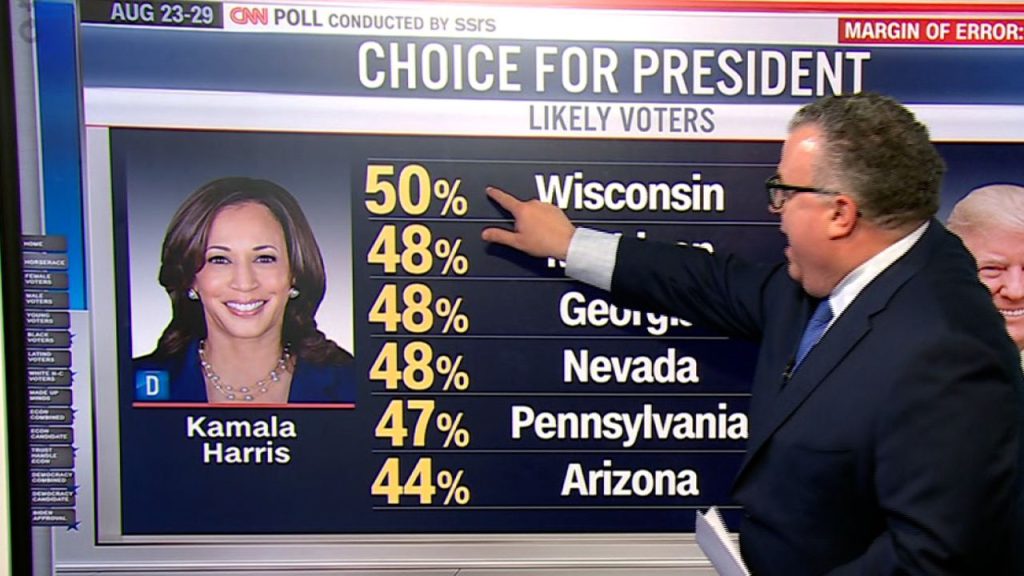Key Battleground States in 2024 Presidential Race: Georgia and Pennsylvania in the Spotlight
3 min read

As the 2024 presidential campaign enters its final stretch, recent CNN polls conducted by SSRS reveal a complex and competitive landscape across six crucial battleground states. The polls indicate that Georgia and Pennsylvania are pivotal in the race, with both states displaying a tight contest between Vice President Kamala Harris and former President Donald Trump.
In Wisconsin and Michigan, Harris holds a lead over Trump, with Harris garnering 50% to Trump’s 44% in Wisconsin and 48% to Trump’s 43% in Michigan. Conversely, Trump leads Harris in Arizona, 49% to 44%. The races in Georgia, Nevada, and Pennsylvania are extremely close, with the candidates nearly splitting the vote in each state. In Georgia and Nevada, Harris is slightly ahead with 48% to Trump’s 47%, while in Pennsylvania, the candidates are tied at 47% each.
These polls suggest a high degree of undecided voters in these states, averaging around 15%. This uncertainty indicates that a significant portion of the electorate could still shift their support as the campaign intensifies in the final weeks leading up to Election Day.
The electoral significance of Pennsylvania and Georgia cannot be overstated. Biden won all six states in 2020, with Georgia and Arizona being particularly close. If Harris can maintain Biden’s victories in the other states and secure wins in Wisconsin and Michigan, capturing Pennsylvania plus any additional electoral vote would secure her the presidency. On the other hand, if Trump retains North Carolina—another battleground state—and wins Georgia and Pennsylvania, he would clinch the presidency regardless of outcomes in Wisconsin, Michigan, or Nevada.
Polling data from August shows that Harris’ performance in Wisconsin and Michigan is driven largely by strong support from the Democratic base. In these states, Harris enjoys solid backing from Democratic voters, particularly among women and those with college degrees. Harris also fares better on issues like abortion and reproductive rights, where she significantly outperforms Trump.
However, Harris faces challenges, particularly on economic issues where Trump holds a considerable lead. Trump is also perceived as more capable on immigration and crime, while Harris has a narrower lead on issues like handling abortion. Notably, Harris’ support among younger voters and Black voters is strong, but these groups show varying levels of enthusiasm and motivation to vote compared to their White counterparts.
In Arizona and Nevada, the dynamics are slightly different. Trump holds a narrow lead in Arizona, where Harris struggles to regain support from key Democratic demographics such as Latino and younger voters. Conversely, in Nevada, Harris leads among Latino voters and maintains stronger support from White voters with college degrees compared to Arizona.
Both states have significant gender gaps, with Harris leading among women and Trump holding an advantage with men. Nevada’s polling shows a clear advantage for Harris among female voters, while Arizona’s gender gap is less pronounced.
The polls also highlight a close race for Senate seats in these battleground states. In Michigan, Nevada, Pennsylvania, and Wisconsin, Democratic incumbents are leading in their races, while in Arizona, the Senate race is competitive, reflecting the state’s overall tight electoral landscape.
Finally, the support for third-party and independent candidates is relatively modest, but in a tight race, even small percentages could influence the outcome. Independent candidates such as Robert F. Kennedy Jr. and Green Party’s Jill Stein have limited support, yet their presence could impact voter preferences.
As the election approaches, the intense competition in Georgia and Pennsylvania, along with the tight races in other battleground states, underscores the unpredictable nature of the 2024 presidential race. The coming weeks will be crucial in determining how undecided voters and key demographics ultimately influence the election’s outcome.